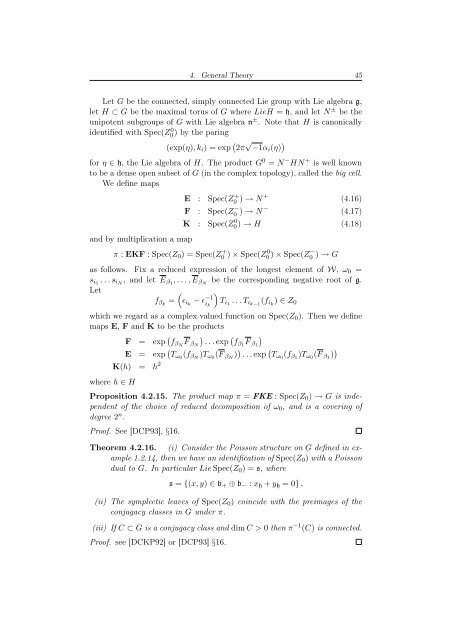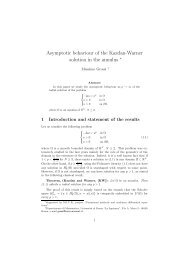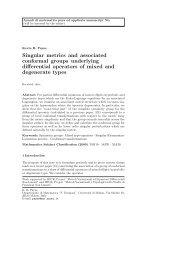Degree of Parabolic Quantum Groups - Dipartimento di Matematica ...
Degree of Parabolic Quantum Groups - Dipartimento di Matematica ...
Degree of Parabolic Quantum Groups - Dipartimento di Matematica ...
You also want an ePaper? Increase the reach of your titles
YUMPU automatically turns print PDFs into web optimized ePapers that Google loves.
4. General Theory 45<br />
Let G be the connected, simply connected Lie group with Lie algebra g,<br />
let H ⊂ G be the maximal torus <strong>of</strong> G where LieH = h, and let N ± be the<br />
unipotent subgroups <strong>of</strong> G with Lie algebra n ± . Note that H is canonically<br />
identified with Spec(Z0 0 ) by the paring<br />
(exp(η), ki) = exp 2π √ −1αi(η) <br />
for η ∈ h, the Lie algebra <strong>of</strong> H. The product G 0 = N − HN + is well known<br />
to be a dense open subset <strong>of</strong> G (in the complex topology), called the big cell.<br />
We define maps<br />
and by multiplication a map<br />
E : Spec(Z + 0 ) → N+<br />
(4.16)<br />
F : Spec(Z − −<br />
0 ) → N (4.17)<br />
K : Spec(Z 0 0) → H (4.18)<br />
π : EKF : Spec(Z0) = Spec(Z + 0 ) × Spec(Z0 0) × Spec(Z − 0 ) → G<br />
as follows. Fix a reduced expression <strong>of</strong> the longest element <strong>of</strong> W, ω0 =<br />
si1 . . .siN , and let Eβ1 , . . .,EβN be the correspon<strong>di</strong>ng negative root <strong>of</strong> g.<br />
Let<br />
fβk =<br />
<br />
. . .Tik−1 (fik ) ∈ Z0<br />
ǫik<br />
− ǫ−1<br />
ik<br />
Ti1<br />
which we regard as a complex valued function on Spec(Z0). Then we define<br />
maps E, F and K to be the products<br />
F = exp fβNF <br />
βN . . .exp fβ1F <br />
β1<br />
E = exp Tω0 (fβN )Tω0 (F βN ) . . .exp Tω0 (fβ1 )Tω0 (F β1 )<br />
K(h) = h 2<br />
where h ∈ H<br />
Proposition 4.2.15. The product map π = FKE : Spec(Z0) → G is independent<br />
<strong>of</strong> the choice <strong>of</strong> reduced decomposition <strong>of</strong> ω0, and is a covering <strong>of</strong><br />
degree 2 n .<br />
Pro<strong>of</strong>. See [DCP93], §16.<br />
Theorem 4.2.16. (i) Consider the Poisson structure on G defined in example<br />
1.2.14, then we have an identification <strong>of</strong> Spec(Z0) with a Poisson<br />
dual to G. In particular LieSpec(Z0) = s, where<br />
s = {(x, y) ∈ b+ ⊕ b− : xh + yh = 0} ,<br />
(ii) The symplectic leaves <strong>of</strong> Spec(Z0) coincide with the preimages <strong>of</strong> the<br />
conjugacy classes in G under π.<br />
(iii) If C ⊂ G is a conjugacy class and <strong>di</strong>mC > 0 then π −1 (C) is connected.<br />
Pro<strong>of</strong>. see [DCKP92] or [DCP93] §16.








